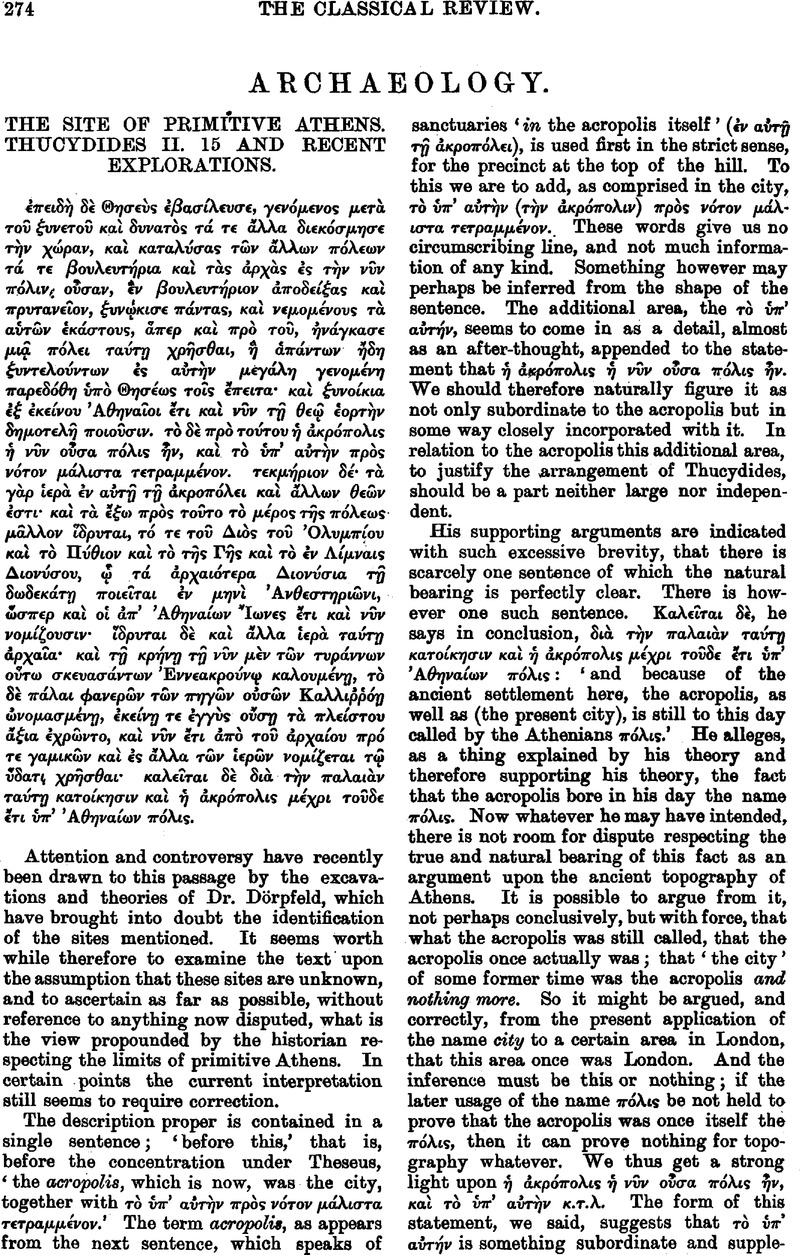No CrossRef data available.
Published online by Cambridge University Press: 27 October 2009

page 275 note 1 So Dr. Dörpfeld and his supporters, to whose arguments so far I have little to add.
page 275 note 2 Mr. L. Whibley has pointed out to me that the contrast between ⋯ θε⋯ς (Athena) and ∘ἱ ἄλλ∘ι θε∘⋯ was actually familiar to the official language. The treasurers of Athena were ταμ⋯αι τ⋯ν τ⋯ς θε∘⋯ or ταμ⋯αι τ⋯ς θε∘⋯, and there was a similar board of ταμ⋯αι τ⋯ν ἄλλων θε⋯ν. See the decree of Callias, C.I.A. i. 32, and compare C.I.A. i. 194. Such a use would greatly aid in interpreting Thucydides' ἄλλ∘ι θε∘⋯ to the ear, even if it were not clear in itself. The decree of Callias also exemplifies the alternative use of π⋯λις and ⋯κρ⋯π∘λις.
page 276 note 1 See Thuc. i 10.
page 277 note 1 The change of ⋯κε⋯νῃ to ⋯κεῖν∘ι is mistaken and obscures the point, which is, that because Callirrhoé (⋯κε⋯νη) was once naturally or necessarily used in a certain way, therefore the water of Enneacrounos, its successor and representative, is still used in a similar way, though in the altered state and circumstances such a use is no longer natural.
page 278 note 1 There is evidence (late) for an Enneacrounos by the Ilissus and near the Fisistratean temple of Zeus Olympios; but this, supposing it trustworthy, raises no difficulty, as there is not the slightest reason for presuming that thu name was unique. The word enneacrounos is, strictly speaking, rather a description than a proper name ; and if ‘the despots’ or their engineers gave such, a form to a fountain in one place, they may well have done so in another or in others ; or again the type may have been imitated in later times. Dr. Dörpfeld would suppose a transference of the name from his original site to the other, but his explanation seems, though possible, artificial, and is in any case not necessary.
page 278 note 2 Nothing can be argued from the title ⋯ν Λ⋯μναις. Inferences from the apparent meaning of proper names, of which the history is beyond investigation, are useless and misleading. The name may have changed its sense, or may be a mere corruption. The sanctuary ἔν Λ⋯μναις may have had no more connexion with any marsh than Burriham Beeches with any beech, or Sandiacre with any sand.
page 283 note 1 Notizie degli Scavi, June 1899.
page 283 note 2 Ibid. July 1899.
page 283 note 3 Ibid. August 1899.
page 284 note 4 Notizie degli Scavi, Sept. 1899.
page 284 note 5 Athenaeum, 17 March, 1900.
page 284 note 6 Athenaeum, 14 April, 1900.
page 284 note 7 Notizie degli Scavi, Jan. 1899.
page 284 note 8 Notizie degli Scavi, March 1899.
page 284 note 9 Ibid. Feb. 1899.
page 285 note 10 Athen. Mittheilungen, 1899, pt. 4, p. 487.